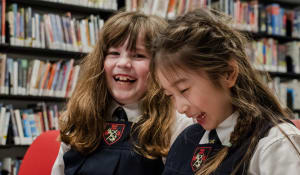Jump to:
At its heart, the importance of school size is related to the trade-off between offering an intimate and comfortable learning environment and a diverse range of opportunities. Smaller schools often have a more intimate environment, while bigger schools tend to offer more diverse opportunities.
It’s important to distinguish school size from other potentially related features. These include the following:
Grades offered and cohort size: When comparing schools, consider the number of grades each school offers. A bigger school may create a close-knit, intimate atmosphere within individual grade cohorts.
Class size: Larger schools may have bigger classes and higher student-to-teacher ratios. That said, some big schools maintain small class sizes and low student-to-teacher ratios to ensure personalized attention and one-on-one support.
Educational approach: A school’s size can reflect its educational philosophy. Schools with alternative curricula may limit enrollment to create a particular learning environment, while schools with boarding programs may have more students. However, there is no fixed relationship between a school’s educational approach and its total enrollment.
Social opportunities: Larger schools generally offer greater diversity in student personalities, academic and extracurricular interests, and socioeconomic and cultural backgrounds. However, smaller schools may also promote diversity through admissions policies and community-building efforts.
Schools’ age: Older schools often have a larger enrollment since they tend to expand over time. Some larger schools have expanded gradually over decades, while others have grown more rapidly. Likewise, smaller schools with a long history may have different growth expectations compared to newer schools of a similar size.
School size does not always reflect its structure, such as the number of grades it offers or the number of classes per grade. For example, two schools with the same total enrollment might have different cohort sizes if one offers more grades than the other. This means that comparing school sizes is most meaningful when looking at schools that offer the same number of grades.
While students often form close relationships with a smaller peer group, bigger schools may give them access to multiple networks of peers with a broad scope of common interests and activities.
In smaller schools, students often participate in a range of different activities with the same group of peers and teachers, which can nurture deeper relationships.
Smaller schools tend to have smaller class sizes and lower teacher-to-student ratios. However, both bigger and smaller schools can have small classes and low student-to-teacher ratios to ensure that students receive personalized attention and engage in interactive learning.
Some school types tend to have fewer students. This includes alternative schools such as Montessori, Waldorf, and Reggio Emilia. This is due to their educational approach (which prioritizes more personalized learning, collaboration, and inter-grade mentorships) and the fact that they’re primarily offered for kids in preschool and elementary school.
Montessori schools, which tend to be smaller, sometimes have higher student-to-teacher ratios to promote independence. Large schools may have bigger classes but often hire more staff or offer smaller classes for subjects needing individualized support.
Boarding schools, meanwhile, are often bigger. If they offer day programs, they’re particularly more likely to have a higher total enrollment. Some boarding schools that don’t have day programs and are offered only to high school-age students are on the smaller side.
Related to school types, it's also worth noting that the present guide doesn't cover virtual or online schools, which operate with different models. For schools that use partial or fully online learning, enrollment size could vary widely based on their platform, programming, and target audience.
A school’s size can affect the amount and kinds of resources it offers. Bigger schools often have more resources, including academic programs and classes in specialized subjects like STEM, robotics, theatre, and fashion design.
Big schools also usually have wide-ranging extracurricular programs and activities in sports, arts, education, and other areas. Many have state-of-the-art facilities like art studios, Olympic-sized pools, and 3D printers and offer support services like tutoring, counselling, and university placement.
Small schools sometimes don’t have this breadth of resources. Almost all, however, offer a range of academics, extracurriculars, and support services like counselling and mentoring. Moreover, a small school might focus and specialize in a handful of athletic, artistic, or other types of extracurricular activities and offer in-depth engagement.
Big schools tend to have more diverse student bodies, which means your child will be exposed to a wide range of backgrounds, personalities, talents, and interests. This increases the chances of finding a compatible peer group.
However, the larger environment can be socially overwhelming, which makes it difficult to form close friendships at first. Many big schools provide counselling and community events to promote a tight-knit community and close friendships.
Small schools maintain a close-knit community where students are more likely to know each other across grades. They tend to form strong friendships quickly. Being part of a smaller community helps students feel recognized and valued. However, with a smaller and sometimes less diverse student body, it can be harder to find like-minded peers. Many small schools address this by offering programs and activities that build strong relationships.
Potential benefits of small schools:
- Close faculty-student relationships enhance support and accountability.
- A tight-knit community can build strong peer bonds, a special perk for shy or introverted students.
- There are more opportunities for non-star athletes and leadership roles in extracurriculars.
- Parents often feel more connected to the school community.
Potential drawbacks of small schools:
- Less diversity in student backgrounds, personalities, and interests.
- Fewer academic programs and course options.
- Fewer extracurricular activities and resources.
Potential benefits of big schools:
- A wider curriculum with specialized courses and expert teachers.
- Broader social opportunities, making it easier to find like-minded peers.
- A diverse range of extracurriculars allows students to explore new interests.
- Competitive sports teams with better coaching and resources.
- Big schools often provide faculty advisors for personalized support.
Potential drawbacks of big schools:
- Larger class sizes and higher student-teacher ratios may not suit all learners.
- A large student body can make social integration challenging.
- Larger administrations may complicate communication between students and parents.
- Fewer opportunities for inter-grade mentorship and friendships.
Total enrollment is just a raw figure. To get a fuller picture of their community and culture, you’ll want to dig deeper and ask schools some key questions
Here are a few to get you started:
- How many students and class cohorts do you have in each grade?
- What is your average class size and teacher-to-student ratio?
- What is the gender makeup of your school (coed, all-boys, or all-girls)?
- How many day and boarding students do you have (assuming both programs are offered)?
- Are you planning to grow your student population?
- Where do your students come from (e.g., cities, provinces, and countries)?
- How many international students do you have?
- Do you cater to specific kinds of students? If so, which kinds?
- What support systems do you have to accommodate different types of students?
- How do you build community spirit and encourage friendships?
Questions to ask bigger schools
- How do you promote individualized learning with a large student body?
- How do you encourage building a strong sense of community (e.g., initiatives, events)?
- Do students have a faculty advisor or dedicated staff member who regularly checks in with them and their parents?
- What student support services do you offer (e.g., tutors, mentors, psychologists, social workers)?
Questions to ask smaller schools
- How diverse is your student body?
- What range of academic programs and extracurricular activities do you offer?
- Do you have specific initiatives and events to expose students to more experiences and activities?
- What additional student support services do you offer (e.g., tutoring, mentoring, counselling, wellness resources)?





















